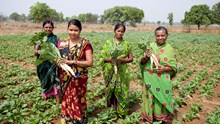
Farmers of states such as Andhra Pradesh, Telangana, Odisha, West Bengal, and Chhattisgarh have depended on Samba Mahsuri since generation. It is a popular rice crop with fine grain and quality. This variety has its own disadvantages like a long maturation period, drought susceptibility, and moderate yields. In the current era, when inputs for agriculture are increasing and water is running short, farmers require rice varieties that can produce faster, require less input, and yet bring maximum market value.
This is where DRR Dhan 100 (also referred to as Kamala) comes into the picture. It is a new variety that not only inherits the features of Samba Mahsuri but also returns much more in the process. It is a scientific breakthrough that speaks the language of the land and knows the pain of the farmer.
What Makes DRR Dhan 100 So Special
Developed through the dedicated efforts of Dr. Satendra K. Mangrauthia, Dr. R.M. Sundaram, and their ICAR-Indian Institute of Rice Research team. This variety is India's first genome-edited rice based on SDN1 technology. The process enables researchers to improve certain natural characteristics of the plant without introducing foreign genes, so the resulting plant will be as natural and acceptable as the traditional types, but with improved performance.
The main advantage of DRR Dhan 100 is that it provides a 19% greater grain yield compared to normal Samba Mahsuri. This can mean a difference of 4 to 5 additional quintals per acre, which directly adds to the farmer’s income.
Additionally, it matures 15 to 20 days in advance, enabling farmers to incorporate an additional crop cycle, conserve water, or escape delays in harvesting during intense monsoons. Early maturity is particularly beneficial in regions with a risk of flooding or waterlogging towards the end of the season.
Scope for Wider Adoption and Income Boost
DRR Dhan 100 is suitable for most areas of lowland rice cultivation in India. Due to early maturity and increased productivity, farmers are able to conserve labor, decrease pest pressure, and escape terminal water stress at the end of the season. This provides a chance for improved cropping patterns—paddy and pulses or vegetables—thus enhancing soil health and income diversification.
In terms of market value, since it retains the popular grain type of Samba Mahsuri, DRR Dhan 100 fetches similar or even better prices. Its earlier maturity too will enable the farmers to reach the market first and benefit from the early-season price spikes.
Government and agricultural universities are already propagating this variety under frontline demonstrations, seed kits, and training programs. Farmers can approach their local KVK or State Agricultural University for availability of quality seed.
A Scientific Solution Rooted in Farmers’ Needs
DRR Dhan 100 is more than just a rice variety, it is a scientifically developed hope that is adapted to our farmers' daily challenges. Kamala is a trustworthy partner in the paddy field in a world where every drop of water and every day of delay can have a significant financial impact. This type is an excellent choice for growers that want to strike a balance between quantity, quality, and climatic adaptation.
As India moves closer to Atmanirbhar agriculture, developments such as DRR Dhan 100 serve as a reminder that science can truly transform the fields and families that provide our country with food when paired with local knowledge and farmer involvement.
















